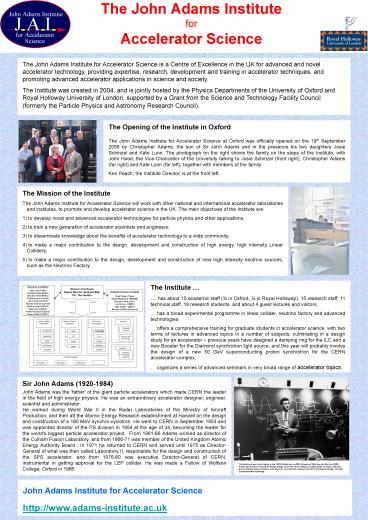The John Adams Institute for Accelerator Science - PowerPoint PPT Presentation
1 / 1
Title:
The John Adams Institute for Accelerator Science
Description:
... John Adams and in the presence his two daughters Josie Schinzel and Kate Lunn. ... The John Adams Institute for Accelerator Science will work with other ... – PowerPoint PPT presentation
Number of Views:34
Avg rating:3.0/5.0
Title: The John Adams Institute for Accelerator Science
1
The John Adams Institute for Accelerator Science
The John Adams Institute for Accelerator Science
is a Centre of Excellence in the UK for advanced
and novel accelerator technology, providing
expertise, research, development and training in
accelerator techniques, and promoting advanced
accelerator applications in science and
society. The Institute was created in 2004, and
is jointly hosted by the Physics Departments of
the University of Oxford and Royal Holloway
University of London, supported by a Grant from
the Science and Technology Facility Council
(formerly the Particle Physics and Astronomy
Research Council).
The Opening of the Institute in Oxford The John
Adams Institute for Accelerator Science at Oxford
was officially opened on the 19th September 2006
by Christopher Adams, the son of Sir John Adams
and in the presence his two daughters Josie
Schinzel and Kate Lunn. The photograph on the
right shows the family on the steps of the
Institute, with John Hood, the Vice-Chancellor of
the University talking to Josie Schinzel (front
right), Christopher Adams (far right) and Kate
Lunn (far left), together with members of the
family. Ken Peach, the Institute Director, is at
the front left.
- The Mission of the Institute
- The John Adams Institute for Accelerator Science
will work with other national and international
accelerator laboratories and institutes, to
promote and develop accelerator science in the
UK. The main objectives of the Institute are - to develop novel and advanced accelerator
technologies for particle physics and other
applications - to train a new generation of accelerator
scientists and engineers - to disseminate knowledge about the benefits of
accelerator technology to a wide community - to make a major contribution to the design,
development and construction of high energy, high
intensity Linear Colliders - to make a major contribution to the design,
development and construction of new high
intensity neutrino sources, such as the Neutrino
Factory.
The Institute has about 15 academic staff (¾
in Oxford, ¼ in Royal Holloway), 15 research
staff, 11 technical staff, 18 research students,
and about 4 guest lectures and visitors has a
broad experimental programme in linear collider,
neutrino factory and advanced technologies
offers a comprehensive training for graduate
students in accelerator science, with two terms
of lectures in advanced topics in a number of
subjects, culminating in a design study for an
accelerator previous years have designed a
damping ring for the ILC and a new Booster for
the Diamond synchrotron light source, and this
year will probably involve the design of a new 50
GeV superconducting proton synchrotron for the
CERN accelerator complex organizes a series of
advanced seminars in very broad range of
accelerator topics.
Sir John Adams (1920-1984) John Adams was the
'father' of the giant particle accelerators which
made CERN the leader in the field of high energy
physics. He was an extraordinary accelerator
designer, engineer, scientist and administrator.
He worked during World War II in the Radar
Laboratories of the Ministry of Aircraft
Production, and then att the Atomic Energy
Research establishment at Harwell on the design
and construction of a 180 MeV synchro-cyclotron.
He went to CERN in September 1953 and was
appointed director of the PS division in 1954 at
the age of 34, becoming the leader for the
world's biggest particle accelerator project.
From 1961-66 Adams worked as director of the
Culham Fusion Laboratory, and from 1966-71 was
member of the United Kingdom Atomic Energy
Authority Board. In 1971 he returned to CERN and
served until 1975 as Director-General of what was
then called Laboratory II, responsible for the
design and construction of the SPS accelerator,
and from 1976-80 was executive Director-General
of CERN, instrumental in getting approval for the
LEP collider. He was made a Fellow of Wolfson
College, Oxford in 1966.
The picture shows John Adams in the CERN
Auditorium on 25th November 1959, the day after
the CERN Proton Synchrotron reached its design
energy of 24 GeV. He is holding an empty bottle
of vodka, sent from the Accelerator group at
Dubna, near Moscow, who held the previous record
for the highest energy (10 GeV) accelerator then
operating.
John Adams Institute for Accelerator
Science http//www.adams-institute.ac.uk































